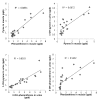1-OH-Pyrene and 3-OH-Phenanthrene in Urine Show Good Relationship with their Parent Polycyclic Aromatic Hydrocarbons in Muscle in Dairy Cattle
- PMID: 24278545
- PMCID: PMC3834509
- DOI: 10.5487/TR.2011.27.1.015
1-OH-Pyrene and 3-OH-Phenanthrene in Urine Show Good Relationship with their Parent Polycyclic Aromatic Hydrocarbons in Muscle in Dairy Cattle
Abstract
The toxicities of phenanthrene (PH) and pyrene (PY) are less than benzo (a) pyrene (BaP) , but both compounds are found in higher concentrations in the air, feed, and food. Most PAHs are metabolized to hydroxylated compounds by the hepatic cytochrome P450 monooxigenases system. Metabolites are excreted into urine and feces. We determined concentrations of PH, PY and BaP in muscle and hydroxylated metabolites, 3-OH-PH, 1-OH-PY, and 3-OH-BaP, respectively, in urine from dairy cattle (n = 24) . We also evaluated the relationship between parent compounds in muscle and their metabolites in urine. Concentrations of PH and PY in muscle ranged from 0.7~4.8 ng/g (1.8 ± 1.7) and 0.4~4.1 ng/g (1.2 ± 1.2) , respectively. Concentrations of 3-OH-PH and 1-OH-PY in urine ranged from 0.1~5.9 ng/ml (2.9 ± 3.7) and 0.5~3.6 ng/ml (1.9 ± 2.3) , respectively. Correlation coefficient for PY concentration in muscle versus 1-OH-PY in urine was 0.657 and for PH concentration in muscle versus 3-OH-PH in urine was 0.579.Coefficient determination for PY and PH concentrations in muscle was 0.886 and for 1-OH-PY and 3-OHPH in urine was 0.834. This study suggests that 1-OH-PY and 3-OH-PH could be used as biomarkers for PAHs exposure in dairy cattle.
Keywords: 1-OH-Pyrene; 3-OHPhenanthrene; Dairy cattle; Exposure biomarker; Polycyclic aromatic hydrocarbons.
Figures
Similar articles
-
Changes of biomarkers with oral exposure to benzo(a)pyrene, phenanthrene and pyrene in rats.J Vet Sci. 2007 Dec;8(4):361-8. doi: 10.4142/jvs.2007.8.4.361. J Vet Sci. 2007. PMID: 17993750 Free PMC article.
-
Milk and urine excretion of polycyclic aromatic hydrocarbons and their hydroxylated metabolites after a single oral administration in ruminants.J Dairy Sci. 2007 Jun;90(6):2624-9. doi: 10.3168/jds.2006-806. J Dairy Sci. 2007. PMID: 17517702
-
Human health risks estimations from polycyclic aromatic hydrocarbons in serum and their hydroxylated metabolites in paired urine samples.Environ Pollut. 2021 Dec 1;290:117975. doi: 10.1016/j.envpol.2021.117975. Epub 2021 Aug 14. Environ Pollut. 2021. PMID: 34416499
-
3-Hydroxybenzo[a]pyrene in the urine of workers with occupational exposure to polycyclic aromatic hydrocarbons in different industries.Occup Environ Med. 2008 Apr;65(4):224-9. doi: 10.1136/oem.2006.030809. Epub 2007 Apr 20. Occup Environ Med. 2008. PMID: 17449565
-
Polycyclic aromatic hydrocarbon (PAH) metabolites in marine fishes as a specific biomarker to indicate PAH pollution in the marine coastal environment.J Environ Sci Health A Tox Hazard Subst Environ Eng. 2008 Feb 15;43(3):219-26. doi: 10.1080/10934520701792662. J Environ Sci Health A Tox Hazard Subst Environ Eng. 2008. PMID: 18205051
References
-
- Chetiyanukornkul T. Toriba A. Kameda T. Tang N. Hayakawa K. Simultaneous determination of urinary hydroxylated metabolites of naphthalene fluorene phenanthrene, fluoranthene and pyrene as multiple biomarkers of exposure to polycyclic aromatic hydrocarbons. Anal. Bioanal. Chem. 2006;386:712–718. doi: 10.1007/s00216-006-0628-6. - DOI - PubMed
-
- Elovaara E. Mikkola J. Stockmann-Juvala H. Luukkanen L. Keski-Hynnila H. Kostiainen R. Pasanen M. Pelkonen O. Vainio H. Polycyclic aromatic hydrocarbon (PAH) metabolizing enzyme activities in human lung and their inducibility by exposure to naphthalene phenanthrene pyrene chryseneand benzo (a) pyrene as shown in the rat lung and liver. Arch. Toxicol. 2007;81:169–182. doi: 10.1007/s00204-006-0135-8. - DOI - PubMed
LinkOut - more resources
Full Text Sources


